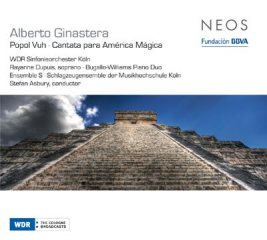Ginastera - Popol Vuh; Cantata para América Mágica (2010)
Ginastera - Popol Vuh; Cantata para América Mágica (2010)

Popol Vuh, for orchestra, Op. 44 1 1. La noche de los tiempos (The Everlasting Night) 2 2. El nacimiento de la tierra (The Birth of the Earth) 3 3. El despertar de la naturaleza (Nature Wakes) 4 4. El grito de la creacion (The Cry of Creation) 5 5. La gran lluvia (The Grand Rain) 6 6. La ceremonia magica del maiz (The Magic Ceremony of Indian Corn) 7 7. El sol, la luna, las estrellas (The Sun, the Moon, the Stars) Cantata for Magic America, for soprano & percussion orchestra, Op. 27 8 1. Preludio y canto a la aurora (Prelude and Song of Dawn) 9 2. Nocturno y canto de amor (Nocturne and Love Song) 10 3. Canto para la partida de los guerreros (Song for the Warriors) 11 4. Interludio fantastico (Fantastic Interlude) 12 5. Canto de agonia y desolacion (Song of Agony and Desolation) 13 6. Canto de la profecia (Song of Prophecy) Rayanne Dupuis – soprano Ensemble S Schlagzeugensemble der Musikhochschule Köln Bugallo-Williams Piano Duo Stefan Asbury - conductor
Alberto Ginastera left his massive orchestral piece Popol Vuh, which had been commissioned by Eugene Ormandy, unfinished at his death in 1983, and it was only after it was discovered by pianist Barbara Nissman that it had its premiere in 1989, with Leonard Slatkin and Saint Louis Symphony. A musical reimagining of Mayan creation mythology, it's a monumental piece that viscerally evokes a primitive world using both folk elements and sophisticated modernist techniques. The composer wrote that he was aiming for a "reconstitution of the transcendental aspect of the ancient pre-Columbian world," and the piece is fully successful at capturing that vision with music that is powerfully primal, strange, and darkly beautiful. Although Ginastera never composed the final movement, The Dawn of Mankind, the seventh, The Sun, the Moon, and the Stars, makes a magnificent finale, so the whole work seems integrated and satisfyingly complete. Stefan Asbury leads WDR Sinfonieorchester Köln in a performance that captures both the work's gravity and its dazzling explosiveness.
Ginastera wrote Cantata para América Magica, scored for soprano, 13 percussionists and 2 pianos, in 1960, during the period when his music was largely influenced by serialism and postwar European trends. The pre-Columbian texts are similar in tone to those on which he drew for Popol Vuh, but this work is clearly modernist, and in spite of its colorful use of a massive percussion ensemble, is less emotionally communicative and packs nowhere near the punch of the orchestral work. Soprano Rayanne Dupuis manages the solo part, but she doesn't have a particularly sensuous instrument and lacks the assurance and vocal heft to bring it fully to life. Schlagzeugensemble der Musikhochschule Köln, Ensemble S, and the Bugallo-Williams Piano Duo, led by Asbury, play with astonishing virtuosity. The sound of Neos' SACD is clear and clean, but in the cantata, doesn't always succeed in managing the tricky balance between the soloists and the massive arsenal of percussionists. --- Stephen Eddins, Rovi
download: uploaded anonfiles yandex 4shared solidfiles mediafire mega filecloudio
Last Updated (Friday, 22 November 2013 15:06)








